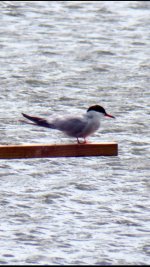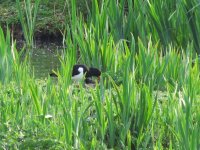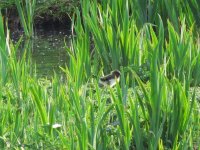-
Welcome to BirdForum, the internet's largest birding community with thousands of members from all over the world. The forums are dedicated to wild birds, birding, binoculars and equipment and all that goes with it.
Please register for an account to take part in the discussions in the forum, post your pictures in the gallery and more.
You are using an out of date browser. It may not display this or other websites correctly.
You should upgrade or use an alternative browser.
You should upgrade or use an alternative browser.
Upton Warren (29 Viewers)
- Thread starter andythomas
- Start date
More options
Who Replied?GaseousClay
Well-known member
Common Tern Sarah. The black tip to the beak is an indicator. Artic's have an all orange/red beak
mattgibbs
Well-known member
Help the apprentice please. 😊 common or Arctic tern? I have no idea what the difference is I took this a few weeks ago and its bugging me now!!!!
Hi, it's a Common Tern. The black tip to the bill is clear in this picture. :t:
mattgibbs
Well-known member
A quick visit to the Moors this morning at 6am prior to a trip to Slimbridge produced 4 Common Terns, Med Gull still watching over nest on large shingle island, 40+ Sand Martins, a few Swallow and House Martins, 2 Swifts, Kingfisher, Sedge Warbler, 2 Cetti's Warblers, 2 Lapwing, 2 Oystercatcher, Stock Dove.
upstarts1979
Well-known member
Looks like the Sand Martin box might have a tenant. Phil W spotted this Wren going in & out of the top right hole.
At last something8-P
upstarts1979
Well-known member
Moors:am
Shoveler pr, shelduck, Oystercatcher 6, Common Tern 6, Med Gull, Kestrel, swift 120 - 150
cettis w,
Flashes:
Teal fem, shoveler pr, gadwall 3 (pr + male), shelduck 6 (3 prs), tufted 15/20
Avocet 24 + 20 chicks (4:4:3:3:3:2:1), lapwing 12 - 14 (6 sitting), LRP 4, Oystercatcher 2, common sand, Med Gull 2nd summer (from Moors),
Kestrel, raven 2, stock dove 3, whitethroat,
Sailing pool:
Lesser whitethroat - east side.
North Moors:
Shoveler pr, tufted 8, water rail, cettis w, sedge w 2, reed w 3, reed bunting.
Shoveler pr, shelduck, Oystercatcher 6, Common Tern 6, Med Gull, Kestrel, swift 120 - 150
cettis w,
Flashes:
Teal fem, shoveler pr, gadwall 3 (pr + male), shelduck 6 (3 prs), tufted 15/20
Avocet 24 + 20 chicks (4:4:3:3:3:2:1), lapwing 12 - 14 (6 sitting), LRP 4, Oystercatcher 2, common sand, Med Gull 2nd summer (from Moors),
Kestrel, raven 2, stock dove 3, whitethroat,
Sailing pool:
Lesser whitethroat - east side.
North Moors:
Shoveler pr, tufted 8, water rail, cettis w, sedge w 2, reed w 3, reed bunting.
Phil Andrews
It's only Rock and Roller but I like it

Have we lost an entire brood of three young Avocet comparing today's count with Dave J's from Sunday?
Phil,I came across this strange creature in Holkham Pines yesterday - can anyone help me identify it? I am struggling to tie it down to any known species; is it a weird hybrid or some form of unsanctioned release?
I think you'll agree that it look like 'Prescotti nilfacefungii' sub species 'nowifiintenti' :t::t::t:
Or a subject for a caption competition?
The Wildfowl and Wetlands Trust is leading a campaign to stop the Birds Directive and the Habitats Directive being scrapped (which protect rare species and important habitats such as the Natura 2000 sites)
Their campaign is here.
Great to see pictures of the Little Gull. Can't wait to get back to UW in the Summer.
Their campaign is here.
Great to see pictures of the Little Gull. Can't wait to get back to UW in the Summer.
mattgibbs
Well-known member
The Wildfowl and Wetlands Trust is leading a campaign to stop the Birds Directive and the Habitats Directive being scrapped (which protect rare species and important habitats such as the Natura 2000 sites)
Their campaign is here.
Great to see pictures of the Little Gull. Can't wait to get back to UW in the Summer.
Thanks for raising this. Signed. It takes a minute to do and the more voices the better to protect vital habitat.
Phil Andrews
It's only Rock and Roller but I like it

Moors:am
Shoveler pr, shelduck, Oystercatcher 6, Common Tern 6, Med Gull, Kestrel, swift 120 - 150
cettis w,
Flashes:
Teal fem, shoveler pr, gadwall 3 (pr + male), shelduck 6 (3 prs), tufted 15/20
Avocet 24 + 20 chicks (4:4:3:3:3:2:1), lapwing 12 - 14 (6 sitting), LRP 4, Oystercatcher 2, common sand, Med Gull 2nd summer (from Moors),
Kestrel, raven 2, stock dove 3, whitethroat,
Sailing pool:
Lesser whitethroat - east side.
North Moors:
Shoveler pr, tufted 8, water rail, cettis w, sedge w 2, reed w 3, reed bunting.
This evening Dave J reports 13 Common Tern, Med Gull (2s) and Otter at the Moors Pool; at the Flashes 30 adult + 23 young in 8 broods of Avocet, Cuckoo and female Teal
Dick-E-Dipper
Well-known member
1991 - one paired with a Canada Goose
1992 - one paired with a Canada Goose, producing a hybrid offspring
2007 - one pair produced one gosling which emerged on the 17th May (killed 12 days later by the resident male Mute Swan)
2008 - one pair bred at the Moors Pool, hatching five goslings from the 9th May (only one was present by the 23rd May and not noted at all in June)
2009 - one pair bred at the Sailing Pool, hatching eight goslings from the 2nd May, of which seven progressed to fledging
2015 - one pair bred at the Sailing Pool, hatching four goslings
Phil
A bit late reporting this, but a pair of Greylags with 3 pos 4 young were on the Shingle Island (Med Gull Island!) at the Moors Pool on Thurs 7 May.
Would they be the same as those on the Sailing Pool? Would they bother making the journey with such young goslings?
Richard
upstarts1979
Well-known member
Have we lost an entire brood of three young Avocet comparing today's count with Dave J's from Sunday?
Dave saw all 8 broods tonight. :t:
Phil Andrews
It's only Rock and Roller but I like it

Phil
A bit late reporting this, but a pair of Greylags with 3 pos 4 young were on the Shingle Island (Med Gull Island!) at the Moors Pool on Thurs 7 May.
Would they be the same as those on the Sailing Pool? Would they bother making the journey with such young goslings?
Richard
Cheers Richard. Personally I would imagine they are one and the same; we have previously had Tufted Ducks that have moved their brood from the Flashes to the Moors Pool (and then back again)
Phil Andrews
It's only Rock and Roller but I like it

Update on Avocet broods
Brood A - 4 young hatched from the left hand side of the peninsular. Still have 4 young, currently located on the foreshore to the left of the hide
Brood B - 4 young hatched from the left hand of "pipe" island. Still have four young, now relocated to the "saucer" (ringed bird "64" appears to be the father)
Brood C - 3 young hatched from the "pipe" island. Still have 3 young, currently located on the foreshore to the far left of the hide.
Brood D - 2 young hatched from one of the small islands in the saucer. Still have 2 young, currently ranging between the right hand side of the peninsular to the left hand end of the delta
Brood E - 3 young hatched from the right hand of the pair of second Flash islands. Still have 2 young, ranging between the right hand side of the delta and the secondary fox fence
Brood F - 4 young hatched from the right hand of the pair of second Flash islands. Now reduced to 3 young, currently on the "beach" in front of the third Flash
Brood G - 3 young more recently hatched from one of the islands in the "saucer". Still has 3 young, currently located on the far shore near the sewage works
Brood H - 1 young more recently hatched from island just right of the peninsular. Still has 1 young, currently located at the end of the peninsular
So in summary, to date 8 broods have hatched 24 young with 23 still surviving. Will see if there is any up-to-date research on Avocet mortality rates; suspect Upton is far ahead of the flagship reserves of Norfolk and Suffolk.
Brood A - 4 young hatched from the left hand side of the peninsular. Still have 4 young, currently located on the foreshore to the left of the hide
Brood B - 4 young hatched from the left hand of "pipe" island. Still have four young, now relocated to the "saucer" (ringed bird "64" appears to be the father)
Brood C - 3 young hatched from the "pipe" island. Still have 3 young, currently located on the foreshore to the far left of the hide.
Brood D - 2 young hatched from one of the small islands in the saucer. Still have 2 young, currently ranging between the right hand side of the peninsular to the left hand end of the delta
Brood E - 3 young hatched from the right hand of the pair of second Flash islands. Still have 2 young, ranging between the right hand side of the delta and the secondary fox fence
Brood F - 4 young hatched from the right hand of the pair of second Flash islands. Now reduced to 3 young, currently on the "beach" in front of the third Flash
Brood G - 3 young more recently hatched from one of the islands in the "saucer". Still has 3 young, currently located on the far shore near the sewage works
Brood H - 1 young more recently hatched from island just right of the peninsular. Still has 1 young, currently located at the end of the peninsular
So in summary, to date 8 broods have hatched 24 young with 23 still surviving. Will see if there is any up-to-date research on Avocet mortality rates; suspect Upton is far ahead of the flagship reserves of Norfolk and Suffolk.
upstarts1979
Well-known member
Brood A - 4 young hatched from the left hand side of the peninsular. Still have 4 young, currently located on the foreshore to the left of the hide
Brood B - 4 young hatched from the left hand of "pipe" island. Still have four young, now relocated to the "saucer" (ringed bird "64" appears to be the father)
Brood C - 3 young hatched from the "pipe" island. Still have 3 young, currently located on the foreshore to the far left of the hide.
Brood D - 2 young hatched from one of the small islands in the saucer. Still have 2 young, currently ranging between the right hand side of the peninsular to the left hand end of the delta
Brood E - 3 young hatched from the right hand of the pair of second Flash islands. Still have 2 young, ranging between the right hand side of the delta and the secondary fox fence
Brood F - 4 young hatched from the right hand of the pair of second Flash islands. Now reduced to 3 young, currently on the "beach" in front of the third Flash
Brood G - 3 young more recently hatched from one of the islands in the "saucer". Still has 3 young, currently located on the far shore near the sewage works
Brood H - 1 young more recently hatched from island just right of the peninsular. Still has 1 young, currently located at the end of the peninsular
So in summary, to date 8 broods have hatched 24 young with 23 still surviving. Will see if there is any up-to-date research on Avocet mortality rates; suspect Upton is far ahead of the flagship reserves of Norfolk and Suffolk.
Some of the chicks have moved around a bit now Phil. Although same feeding areas utilised as in previous years. I was confused when you mention 'pipe island' - I refer to this as 1st Flash island. The pipe island is in the NE corner of the 'saucer' where the pipes used to be around the edge - here 1 poss 2 are sitting:t:.
Lessons for Upton Warren
Yesterday a number of us from the Tuesday work-party were shown around Wilden, another large reserve overseen by Worcestershire Wildlife Trust. It was a most enjoyable and instructive visit: apart from the impressive variety of terrain and the achievements of the Trust and their partners, there were two points that I think have relevance for UW.
1) Reserves have to be managed or they become wildlife deserts:
For many years Wilden was largely marsh and it was home to breeding snipe and lapwing. However, the river levels were allowed to fall as a result of dredging and the land began to dry out. Also willows and other trees were allowed to grow unhindered. As a consequence the marsh disappeared and so did the breeding waders.
Because of its SSSI status measures have been taken to remedy the situation - but at some cost (1 £m to keep up water levels in the river) - and many trees have been removed or coppiced. The reserve is boggy now and looks as if it will attract waders again.
2) One way to deal with the invasive Himalayan Balsam.
Andy Harris, our helpful guide, pointed out an area that was once head-high with scrub and Himalayan Balsam but is now low grass and interesting marshland flowers. The Balsam was eradicated by a special breed of Shetland cattle that were fed on the balsam as calves and so became partial to it.
Peter
Yesterday a number of us from the Tuesday work-party were shown around Wilden, another large reserve overseen by Worcestershire Wildlife Trust. It was a most enjoyable and instructive visit: apart from the impressive variety of terrain and the achievements of the Trust and their partners, there were two points that I think have relevance for UW.
1) Reserves have to be managed or they become wildlife deserts:
For many years Wilden was largely marsh and it was home to breeding snipe and lapwing. However, the river levels were allowed to fall as a result of dredging and the land began to dry out. Also willows and other trees were allowed to grow unhindered. As a consequence the marsh disappeared and so did the breeding waders.
Because of its SSSI status measures have been taken to remedy the situation - but at some cost (1 £m to keep up water levels in the river) - and many trees have been removed or coppiced. The reserve is boggy now and looks as if it will attract waders again.
2) One way to deal with the invasive Himalayan Balsam.
Andy Harris, our helpful guide, pointed out an area that was once head-high with scrub and Himalayan Balsam but is now low grass and interesting marshland flowers. The Balsam was eradicated by a special breed of Shetland cattle that were fed on the balsam as calves and so became partial to it.
Peter
Phil Andrews
It's only Rock and Roller but I like it

Some of the chicks have moved around a bit now Phil. Although same feeding areas utilised as in previous years. I was confused when you mention 'pipe island' - I refer to this as 1st Flash island. The pipe island is in the NE corner of the 'saucer' where the pipes used to be around the edge - here 1 poss 2 are sitting:t:.
First Flash island it is then!
Distribution was based on Dave J 's observations on Sunday; hope to be down myself on Friday pm.
Janner Falcon!
Well-known member
Oyc chick
Moors East hide about 6pm - adult oyc flew from extreme right to extreme left, the returned right and disappeared for a short while. Made another pass and landed on the island where the nest is. Met by adult and lively chick.
Moors East hide about 6pm - adult oyc flew from extreme right to extreme left, the returned right and disappeared for a short while. Made another pass and landed on the island where the nest is. Met by adult and lively chick.
Attachments
Similar threads
- Replies
- 1
- Views
- 1K
Users who are viewing this thread
Total: 30 (members: 0, guests: 30)






